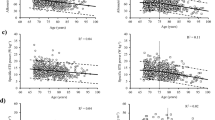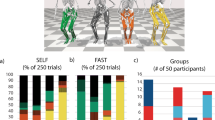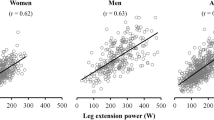Abstract
OBJECTIVES: The aim of this study was to evaluate the typical strategies of obese subjects during a sit-to-stand task (a typical daily living activity) and to assess the load conditions of hip, knee and ankle joints.
DESIGN: Cross-sectional, controlled (obese patients vs controls) study on sit-to-stand movement analysis
SUBJECTS: Ten adult young volunteers (five men and five women, mean age 28, s.d. 3 y; mean BMI 22, s.d. 2.3 kg/m2) and 30 obese subjects 25 women and five men, mean age 39.4, s.d. 13.7 y, mean BMI 40, s.d. 5.9 kg/m2) suffering from chronic lower back pain were analyzed in a sit-to-stand task (10 trials for each subject).
MEASUREMENTS: Angle parameters carried out from a quantitative three-dimensional analysis of sit-to-stand (STS) movement, using an optoelectronic system.
RESULTS: STS task in controls was characterized by a fully forward bending strategy of the trunk, while in obese patients at the beginning (first trial) of the STS task they limited the forward bending in order to protect the vertebral column. When fatigue increased during the execution of multiple STS tasks, the protection of the vertebral column was secondary to the execution of the task. In order to limit the muscle fatigue they increased the forward bending in order to decrease knee joint torque.
DISCUSSION: The analysis of the strategy used by obese patients in STS task can be used in the design of future trials to assess the efficacy of rehabilitative treatment.
This is a preview of subscription content, access via your institution
Access options
Subscribe to this journal
Receive 12 print issues and online access
$259.00 per year
only $21.58 per issue
Buy this article
- Purchase on Springer Link
- Instant access to full article PDF
Prices may be subject to local taxes which are calculated during checkout





Similar content being viewed by others
References
Doorenbosh C, Harlaar J, Roebroeck M, Lankhorst J . Two strategies of transferring from sit-to-stand; the activation of monoarticular and biarticular muscles J Biomech 1994 27: 1299–1307.
Kralj A, Jaeger R, Munih M . Analysis of standing up and sitting down in humans: definitions and normative data presentation J Biomech 1990 23: 1123–1138.
Butler P, Nene A, Major R . Biomechanics of transfer from sitting to standing position in some neuromuscolar diseases Physiotherapy 1991 77: 521–525.
Burdet R, Habasevich R, Pisciotta J, Simon S . Biomechanical comparison of rising from two types of chairs Phys Ther 1985 65: 1177–1183.
Ellis M, Seedhom B, Wright V . Forces in the knee joint whilst rising from a seated position J Biomed Engng 1984 6: 113–120.
Fleckenstein S, Kirby R, MacLeod D . Effect of limited knee flexion range on peak hip moments of forces while transfering from sitting to standing J Biomech 1988 21: 915–918.
Nuzik S, Lamb R, VanSant A, Hirt S . Sit to stand patterns: a kinematic study Phys Ther 1986 66: 1708–1713.
Schultz A, Alexander N, Ashton-Miller J . Biomechanical analyses of rising from a chair J Biomech 1992 25: 1383–1391.
Leboeuf-Yde C, Kyvik KO, Bruun NH . Low back pain and lifestyle. Part II—obesity. Information from a population based sample of 29, 424 twin subjects Spine 1999 24: 779–783.
Garzillo MJ, Garzillo TA . Does obesity cause low back pain? J Manipulative Physiol Ther 1994 17: 601–604.
Divieti L, Galli M, Salvi R . Posture and movement in pregnancy Math Models Meth Appl Sci 1995 5: 145–157.
Berger R, Riley P, Mann R, Hodge W . Total body dynamics in rising from a chair. In Thirty-Fourth Annual Meeting of the Orthopaedic Research Society 1988 Atlanta, GA.
Gregoire L, Veeger H, Huijing P, Schenau G . Role of mono and biarticular muscles in explosive movements Int J Sports Med 1984 5: 301–305.
Kelley D, Dainis A, Wood G . Mechanics and muscular dynamics of rising from a seated position. In: Komi PV (ed). Biomechanics. University Park Press 1976, pp 127–134.
Winter D . Biomechanics of Human Movements Wiley: New York 1979.
Wheeler J, Woodward C, Ucovich R . Rising from a chair: influence of age and design Phys Ther 1985 65: 22–26.
Zatsiorsky V, Seluyanov V . The mass and inertia characteristics of the main segments of the human body. In: Matsui H, Kobayashi K (eds). Biomechanics VIII-B. 1983, pp 1152–1159.
Author information
Authors and Affiliations
Corresponding author
Rights and permissions
About this article
Cite this article
Galli, M., Crivellini, M., Sibella, F. et al. Sit-to-stand movement analysis in obese subjects. Int J Obes 24, 1488–1492 (2000). https://doi.org/10.1038/sj.ijo.0801409
Received:
Revised:
Accepted:
Published:
Issue Date:
DOI: https://doi.org/10.1038/sj.ijo.0801409
Keywords
This article is cited by
-
Evaluation of center of mass estimation for obese using statically equivalent serial chain
Scientific Reports (2022)
-
Gait strategy and body composition in patients with Prader–Willi syndrome
Eating and Weight Disorders - Studies on Anorexia, Bulimia and Obesity (2021)
-
Use of various obesity measurement and classification methods in occupational safety and health research: a systematic review of the literature
BMC Obesity (2018)
-
Effect of hip joint angle at seat-off on hip joint contact force during sit-to-stand movement: a computer simulation study
BioMedical Engineering OnLine (2018)
-
Objective assessment of physical activity and sedentary behaviour in knee osteoarthritis patients – beyond daily steps and total sedentary time
BMC Musculoskeletal Disorders (2018)



